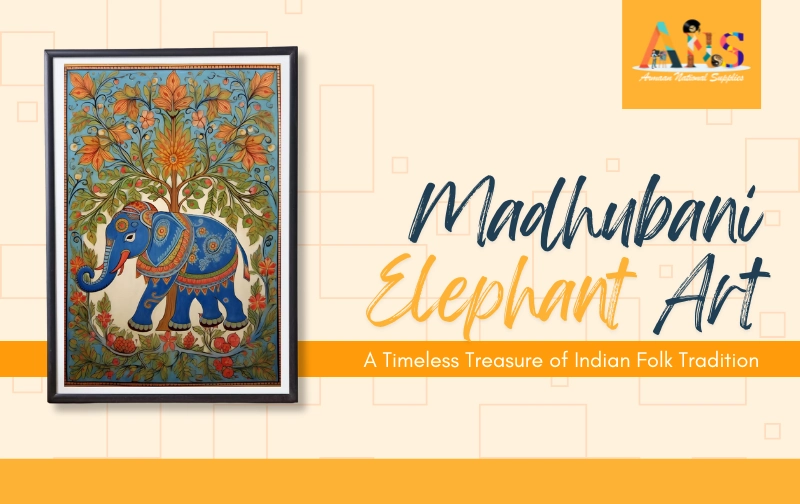LET'S REVIVE YOUR WALL
- Home
- Blog Detail

Madhubani Elephant Art: A Timeless Treasure of Indian Folk Tradition
- March 19, 2025,
Art has been a profound medium of storytelling, culture, and tradition for centuries. Among India's many celebrated art forms, Madhubani art stands out for its intricate patterns, vibrant colors, and deep-rooted history. Among its various themes, the depiction of elephants holds a special place, symbolizing strength, wisdom, and prosperity.
In this blog, we explore the rich heritage of Madhubani Elephant Art: Indian Folk & Vintage Wall Decor, uncovering its history, techniques, significance, and why it continues to captivate art lovers worldwide.
A Glimpse into the History of Madhubani Art
Madhubani art, also known as Mithila painting, originates from the Mithila region of Bihar, India. It is believed to have been practiced since ancient times, with references dating back to the Ramayana era when King Janaka commissioned this art to decorate his daughter Sita’s wedding venue.
Traditionally, Madhubani paintings were created on mud walls using natural dyes and pigments. Over time, artists transitioned to paper, canvas, and cloth, making this folk art more accessible to global enthusiasts. The motifs commonly used in Madhubani paintings include deities, flora, fauna, and celestial bodies, with elephants being a prominent subject.
The Symbolism of Elephants in Indian Folk Art
Elephants hold immense cultural and spiritual significance in Indian traditions. In Hindu mythology, Lord Ganesha, the elephant-headed deity, symbolizes wisdom, good fortune, and the removal of obstacles. Moreover, elephants have been associated with royalty and grandeur, often seen in processions and temple architecture.
In Indian folk art paintings, elephants are depicted with elaborate decorations, intricate patterns, and bright colors, showcasing their majestic and revered nature. Their presence in Madhubani elephant paintings enhances aesthetic appeal and carries deep symbolic meanings of prosperity and stability.
Techniques and Unique Features of Madhubani Elephant Art
What sets Madhubani art apart is its distinctive style and intricate detailing. Artists use fingers, twigs, matchsticks, and brushes to create elaborate patterns with natural colors derived from plants, turmeric, and charcoal. Some key characteristics of Indian folk art painting in Madhubani style include:
- Fine Linework: Delicate, intricate lines create mesmerizing patterns that define the art’s uniqueness.
- Vibrant Colors: Bright shades of red, yellow, green, and blue bring life to the composition.
- Geometric and Floral Borders: The entire painting is often enclosed within decorative frames filled with floral or geometric motifs.
- Minimal Negative Space: Every inch of the canvas is covered with patterns, leaving little to no empty space.
Why Madhubani Elephant Art Makes the Perfect Vintage Wall Decor
If you are looking for vintage art that brings a touch of heritage, elegance, and uniqueness to your space, Madhubani Elephant Art is a perfect choice. Here’s why:
1. Authentic Representation of Indian Folk Tradition
Madhubani paintings are an integral part of India’s rich cultural tapestry. Owning a piece of Indian elephant painting adds an authentic traditional touch to your home or office decor.
2. Vibrant and Eye-Catching Aesthetics
The bold use of colors and intricate designs make Madhubani paintings a focal point in any room. These artworks instantly enhance the ambiance, whether placed in a living room, hallway, or bedroom.
3. Symbol of Strength and Prosperity
Elephants in Madhubani paintings symbolize wisdom, power, and good fortune. Placing an elephant painting in your home will attract positive energy and success.
4. Eco-Friendly and Handcrafted
Madhubani artists often use organic and natural materials, making these paintings an eco-conscious choice for those who appreciate sustainable art forms.
Where to Buy Authentic Madhubani Elephant Paintings
With the increasing popularity of folk art, many online platforms and galleries offer Madhubani paintings. For those looking for genuine and high-quality artwork, Armaan National Supplies is a trusted name in Indian folk art. They provide exquisite collections of Madhubani elephant, showcasing the artistry of skilled Indian craftsmen.
When purchasing an Indian folk art painting, consider factors like authenticity, materials used, and the seller's credibility to ensure you invest in a timeless masterpiece.
Conclusion
Madhubani Elephant Art is not just a painting; it’s a cultural legacy passed down through generations. With its historical significance, symbolic richness, and breathtaking aesthetics, it continues to be a cherished form of Indian folk art. Whether you are an art collector, a history enthusiast, or looking to add an ethnic touch to your home, investing in Madhubani Elephant Art: Indian Folk & Vintage Wall Decor is a decision you won’t regret.
Embrace the timeless beauty of Madhubani paintings and celebrate India’s artistic heritage in your own space!

